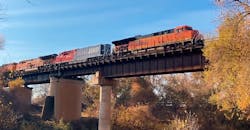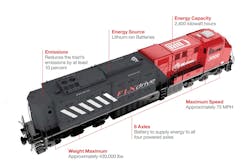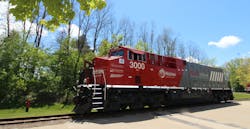The push for a cleaner tomorrow on the nation's railways is now a step closer to the mainstream.
Specifically, Wabtec Corp. today a rail industry first as its FLXdrive battery-electric locomotive delivered more than an 11-percent average reduction in fuel consumption and greenhouse gas emissions for an entire train. It is the equivalent of over 6,200 gallons of diesel fuel saved and approximately 69 tons of CO2 emissions reduced.
This 100-percent battery locomotive, the world’s first, represents a major step in the efforts to decarbonize the freight rail industry. The rail industry is on the cusp of technological advancements required to power locomotive fleets with alternative green energy sources, such as batteries, and eventually, hydrogen fuel cells. And, the potential for this technology is enormous. For each diesel-powered locomotive converted to alternative energy sources up to 3,000 tons of CO2 per year can be eliminated, which will be imperative to achieving a sustainable transportation network.
Lessons learned? Wabtec spokesperson Tim Bader tells IndustryWeek, “The key finding is that we confirmed our hypothesis of energy savings overall with the introduction of the FLXdrive into the train consist,” he says. “Due to the practical variability of train operation in day-to-day service, we found that typically there is even more energy to be harvested than the model would naturally predict.”
“The FLXdrive battery-electric locomotive is a defining moment for freight rail and will accelerate the industry toward low- to zero-emission locomotives,” said CTO Eric Gebhardt, in a statement. “It builds upon the rail industry’s position as the most efficient and sustainable mode of transportation. Building on our long history of pioneering train energy management technologies, this demonstration of coupling 2.4 megawatt hours of battery storage into the mix fully validated our assumptions for the potential for this next generation technology to further drive efficiencies and greenhouse gas reductions. At more than 6 megawatt hours, Wabtec’s next version of FLXdrive technology will have an opportunity to reduce fuel consumption and emissions by up to 30 percent – putting the industry on the cusp of a once-in-a-generation improvement in energy savings and emission reductions.”
The California pilot program was part of a $22.6 million grant from the California Air Resource Board awarded to Wabtec, BNSF and the San Joaquin Valley Air Pollution Control District. The 430,000-pound FLXdrive in the pilot boasts 18,000 lithium-ion battery cells. The battery locomotive charged at the rail yard and recharged during the trip through regenerative braking. The FLXdrive manages the overall train energy flow and distribution through its Trip Optimizer system, an intelligent cruise control system programmed through artificial intelligence to respond to every twist and grade of the track in the most energy-efficient way possible.
Wabtec’s goal is to develop the next generation of zero-emission locomotives. The company has a clear path to power new locomotives – and repower existing locomotives – with batteries, hydrogen internal combustion engines, and hydrogen fuel cells. It is part of Wabtec’s vision for the rail industry to play a key role in building a clean energy economy and reduce carbon emissions globally by up to 300 tons per year.
About the Author
Peter Fretty
Technology Editor
As a highly experienced journalist, Peter Fretty regularly covers advances in manufacturing, information technology, and software. He has written thousands of feature articles, cover stories, and white papers for an assortment of trade journals, business publications, and consumer magazines.


